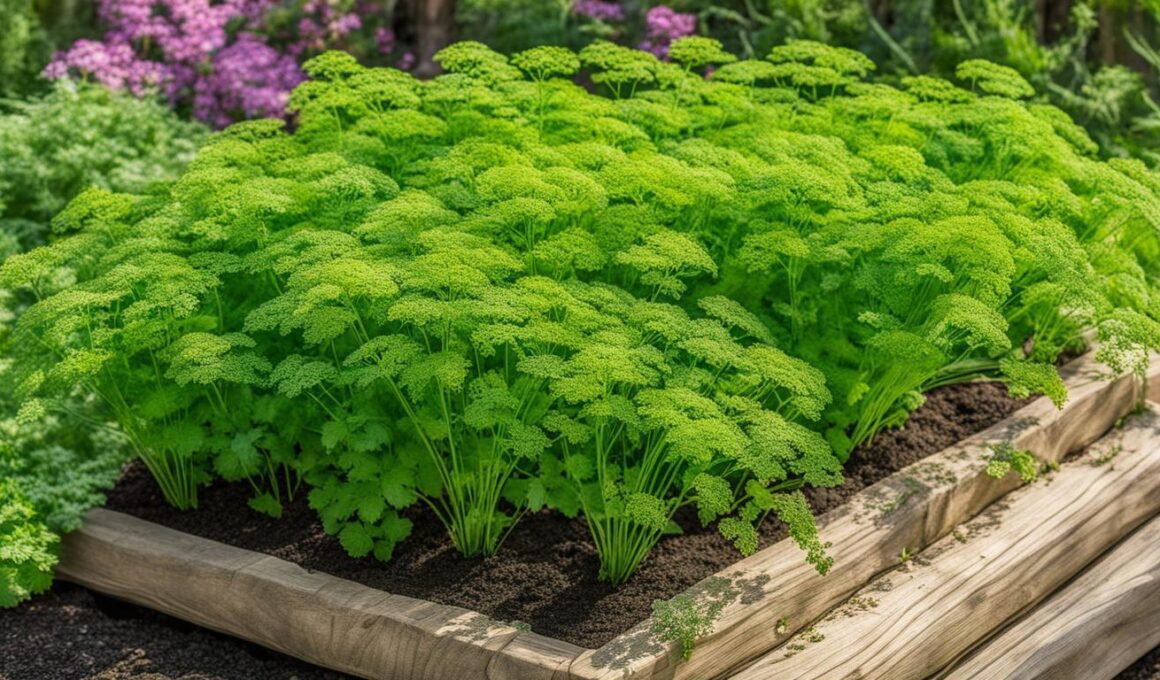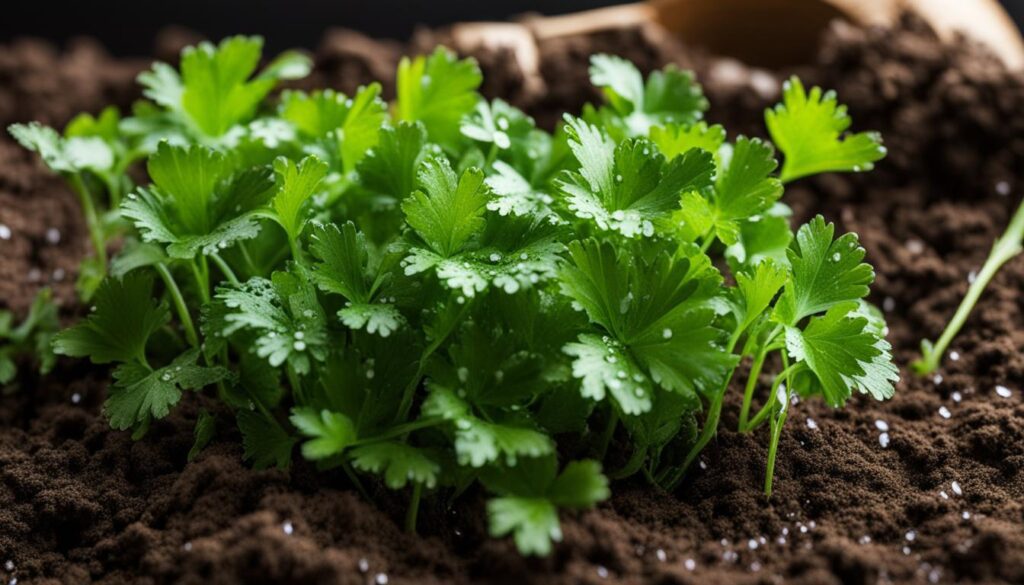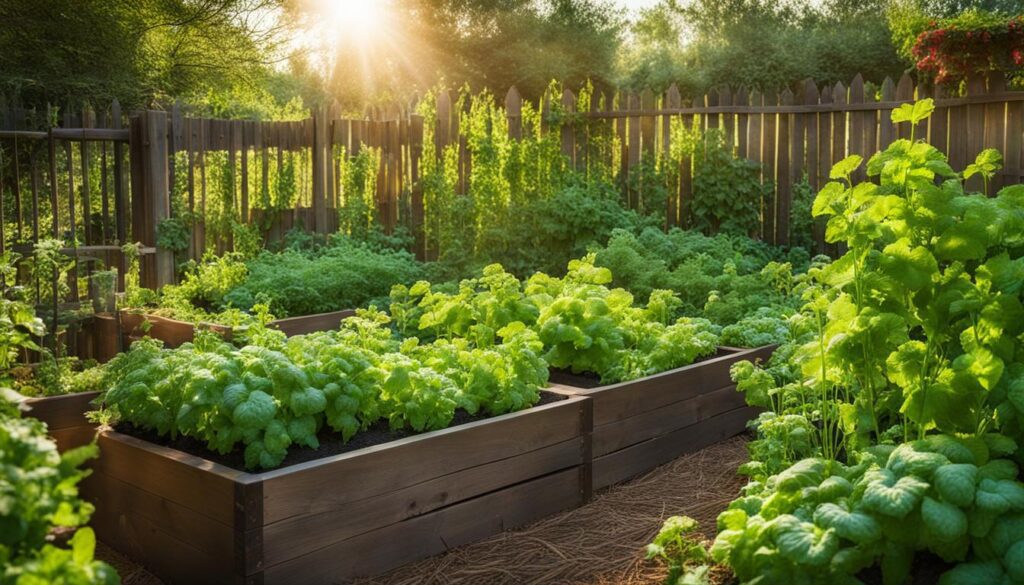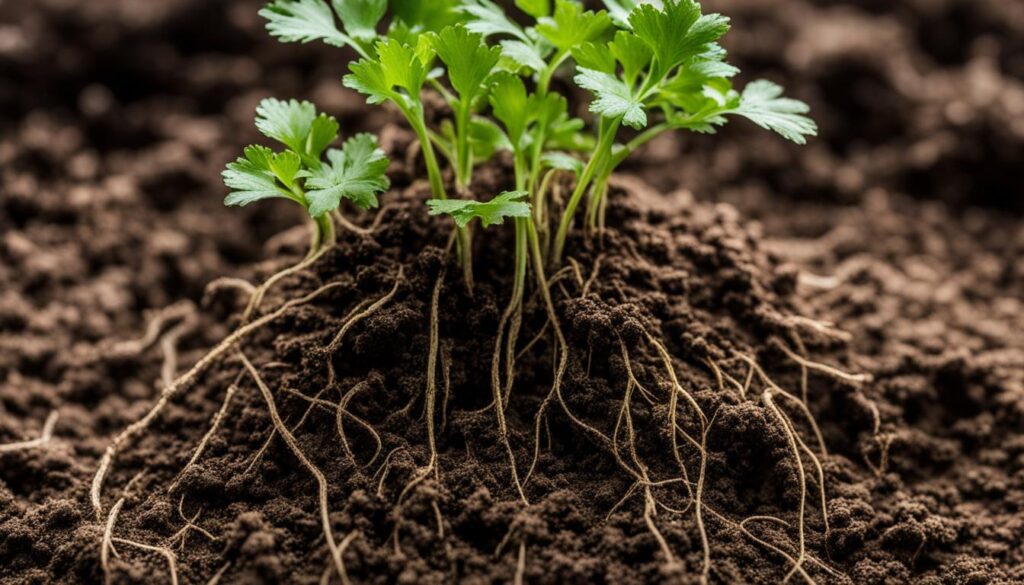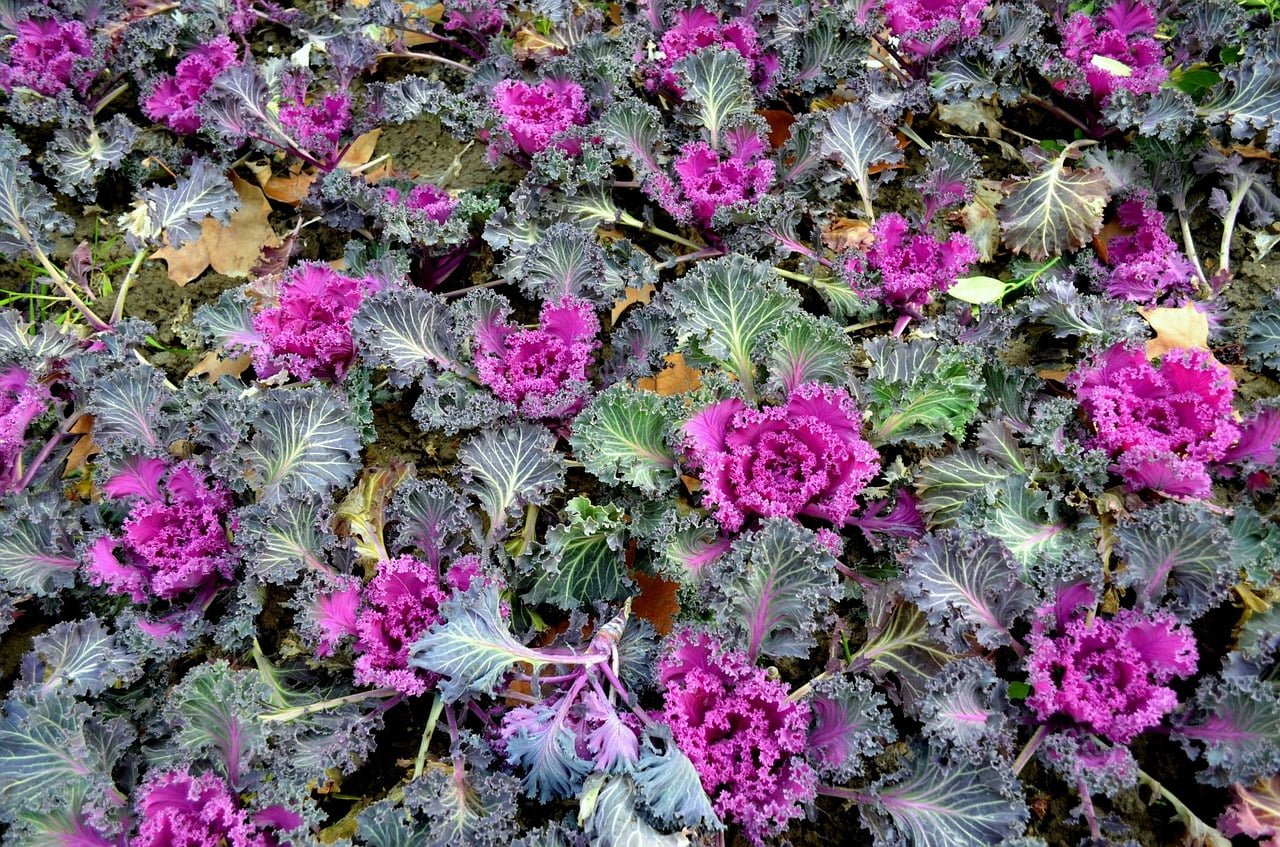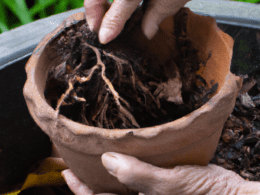Welcome to our comprehensive guide on cilantro cultivation. If you’re wondering how many cilantro plants you should grow per person, you’ve come to the right place. In this article, we will provide you with the recommended number of cilantro plants based on your plant zone. Whether you plan to grow cilantro indoors or outdoors, we’ve got you covered with tips and techniques for successful cultivation. So let’s dive in and discover how to maximize your cilantro yield!
Key Takeaways:
- The recommended number of cilantro plants per person varies depending on the plant zone.
- For zones 3a, 3b, 4a, 4b, 5a, 5b, 6a, 6b, 7a, 7b, 8a, 8b, 9a, 9b, 10a, and 10b, it is suggested to plant 1-2 cilantro plants per person.
- Consider planting more cilantro plants if you intend to preserve coriander seeds.
- Cilantro can be succession planted by sowing new seeds every two weeks until midsummer or trying a second round of planting in the fall.
- Stay tuned for more tips on growing cilantro indoors, outdoors, soil requirements, troubleshooting, and storage in upcoming sections!
Tips for Growing Cilantro Indoors
Growing cilantro indoors can be a rewarding experience, allowing you to enjoy fresh herbs right at your fingertips. To successfully grow cilantro indoors, there are a few key factors to consider.
Light:
Cilantro thrives in bright, indirect light, so it’s important to place your indoor plants in a spot that receives at least five hours of sunlight per day. If natural lighting is insufficient, you can supplement with a grow light to ensure your cilantro receives the necessary light for healthy growth.
Watering:
Proper watering is crucial for cilantro. It’s important to provide moisture without overwatering, as cilantro does not tolerate waterlogged soil. Water lightly, allowing the soil to dry slightly between waterings to prevent root rot.
Soil and Container:
Cilantro prefers well-drained soil, so choose a potting mix that is specifically labeled for indoor vegetable and herb growing. It’s also essential to use a container with good drainage to prevent water accumulation. Ensure the container is large enough to accommodate the growth of the cilantro plants.
By following these tips, you can successfully grow cilantro indoors and enjoy the fresh flavors it brings to your culinary creations.
| Factors for Growing Cilantro Indoors | Tips |
|---|---|
| Light | Place cilantro plants in a brightly lit area, ideally receiving at least five hours of sunlight per day. Supplement with a grow light if necessary. |
| Watering | Water lightly, allowing the soil to dry slightly between waterings to prevent overwatering and root rot. |
| Soil and Container | Use well-drained potting soil labeled for indoor vegetable and herb growing. Ensure the container has good drainage to prevent water accumulation. |
With the right care and attention, you can enjoy a bountiful harvest of cilantro right from your own indoor herb garden. Follow these tips to successfully grow cilantro indoors and enhance your culinary ventures with its fresh and vibrant flavors.
Guidance for Growing Cilantro Outdoors
When it comes to growing cilantro outdoors, there are a few key factors to keep in mind to ensure successful cultivation. Cilantro thrives in cool weather and is best suited for zones 3a, 3b, 4a, 4b, 5a, 5b, 6a, 6b, 7a, 7b, 8a, 8b, 9a, 9b, 10a, and 10b. Before planting, it is important to wait until after the last frost to avoid any damage to the plants.
It’s recommended to start cilantro seeds indoors and then transplant them outside once the weather has warmed up. However, if you prefer, you can also sow the seeds directly in the ground. When planting cilantro, it is crucial to ensure proper spacing between plants. A spacing of 6-8 inches is ideal to allow for healthy growth and airflow.
To ensure an ample supply of cilantro, it is advised to plant 1-2 cilantro plants per person. This will provide a steady harvest throughout the growing season. If you also wish to preserve coriander seeds, you may want to consider planting additional cilantro plants.
Remember to provide regular watering to keep the soil moist but not waterlogged. Adequate sunlight is essential for cilantro to thrive, so choose a location that receives full sun. However, if you live in a hotter climate, cilantro can tolerate light shade. By following these guidelines, you can successfully grow cilantro in your outdoor garden.
Table: Recommended Cilantro Planting Guidelines
| Plant Zone | Recommended Number of Cilantro Plants per Person |
|---|---|
| 3a, 3b, 4a, 4b, 5a, 5b, 6a, 6b, 7a, 7b, 8a, 8b, 9a, 9b, 10a, 10b | 1-2 |
Note: The recommended number of cilantro plants per person may vary depending on personal preferences and the desire to preserve coriander seeds.
Soil, Planting, and Care Tips for Cilantro
When it comes to growing cilantro, proper soil preparation, planting techniques, and attentive care are essential for successful cultivation. Understanding the soil requirements, ideal planting conditions, and care tips will help you maximize the growth and flavor of your cilantro crop.
Soil Requirements
Cilantro thrives in well-drained soil with a pH level between 6.2 and 6.8. Before planting, it’s recommended to amend the soil with aged compost or other rich organic matter to enhance fertility and provide essential nutrients. This will create a favorable growing environment for cilantro plants and contribute to their overall health and productivity.
Planting Cilantro
When planting cilantro, choose a sunny location for optimal growth. Cilantro can tolerate light shade in hotter climates, but it prefers full sun for maximum leaf production. Planting can be done by sowing seeds directly in the ground or starting them indoors and transplanting seedlings once they are established. The seeds should be planted at a depth of about 1/4 to 1/2 inch and spaced 6-8 inches apart.
Cilantro Care
Proper care is crucial for the healthy development of cilantro plants. Regular watering is necessary to maintain soil moisture, especially during dry periods. However, avoid overwatering, as excessive moisture can lead to root rot. Fertilize the cilantro plants with a water-soluble plant food every 3-4 weeks to promote leaf growth and overall vigor. It’s also important to regularly monitor the plants for any signs of pests or diseases and take appropriate measures to control them.
| Planting Tips | Care Tips |
|---|---|
|
|
By following these soil, planting, and care tips, you can ensure the healthy growth of your cilantro plants and enjoy a bountiful harvest of fresh, flavorful cilantro leaves.
Troubleshooting and Maintenance Tips for Cilantro
While cilantro is a relatively easy herb to grow, it may encounter certain issues that can affect its health and productivity. Understanding common cilantro problems and implementing proper maintenance techniques can help ensure a successful harvest. Here are some troubleshooting tips and maintenance practices to consider:
Pest Control:
Cilantro may attract aphids or whitefly infestations, which can damage the leaves and hinder growth. To tackle these insect problems, you can use organic insecticidal soap. Simply mix the recommended amount of soap with water and spray it on the affected leaves, ensuring complete coverage. Regularly inspect your cilantro plants for signs of pests and take action promptly to prevent further damage.
Preventing Wilt and Mildew:
Wilt and mildew can be common issues in cilantro plants, especially if the conditions are too humid or the foliage remains wet for extended periods. To prevent wilt and mildew, practice proper hygiene by removing any spent or infected plants from the vicinity. Ensure adequate air circulation around the plants by spacing them appropriately. Water the plants at the base, avoiding overhead irrigation, which can increase humidity. If mildew does occur, you can utilize organic fungicides or a mixture of baking soda and water to control its spread.
Maintenance and Harvesting:
Cilantro is known for its fast growth and tendency to bolt (produce flowers and seeds) quickly. To maintain the plant effectively, it’s crucial to understand its growth cycle and implement appropriate harvesting techniques. Avoid cutting more than one-third of the plant at a time, as this may weaken it. Instead, opt for regular, light harvesting by cutting the leafy stems near ground level. This encourages new growth and prolongs the cilantro’s harvestable period.
To maintain the health and productivity of your cilantro, regular feeding is essential. You can use products like Miracle-Gro® Performance Organics® Edibles Plant Nutrition or fish emulsion to provide the necessary nutrients. Follow the instructions on the product packaging for proper application and dosage.
By addressing common issues, implementing maintenance practices, and following proper harvesting and feeding techniques, you can ensure the optimal growth and longevity of your cilantro plants. With these troubleshooting and maintenance tips, you’ll be on your way to a thriving and abundant cilantro harvest.
Harvesting and Storage Tips for Cilantro
Harvesting cilantro leaves is a simple process that can be done throughout the growing season. To harvest, simply snip off the leafy stems near ground level, leaving the central growing point intact. It’s important to avoid excessive harvesting, as this can weaken the plant and stunt its growth. By taking care to only cut one-third of the plant at a time, you can ensure a steady supply of fresh cilantro leaves.
When using cilantro leaves in your recipes, it’s best to add them at the last minute to preserve their flavor. Cilantro leaves have a delicate taste that can quickly fade when exposed to heat or extended cooking times. By adding the leaves towards the end of the cooking process, you can enjoy the full aromatic and flavorful qualities of cilantro in your dishes.
To store cilantro for later use, one common method is to place the freshly harvested leaves in a jar or container with a small amount of water. This helps to keep the leaves hydrated and maintain their freshness for a few days. Alternatively, you can wrap the leaves in a damp paper towel and store them in a plastic bag in the refrigerator. This method can help prolong the shelf life of cilantro leaves for up to a week.
For longer-term storage, cilantro can be frozen or dried. To freeze cilantro, simply wash and pat dry the leaves, then chop them into desired sizes. Place the chopped cilantro in an airtight container or freezer bag and store in the freezer. Frozen cilantro can retain its flavor for several months and is a convenient option for future use.
Drying cilantro is another method to preserve its flavor. To dry cilantro, remove the leaves from the stems and spread them out in a single layer on a paper towel or drying rack. Place the leaves in a well-ventilated area away from direct sunlight and allow them to air dry for about one to two weeks, or until fully dried and crispy. Once dried, store the cilantro leaves in an airtight container in a cool, dark place. Dried cilantro can be used in cooking by crushing the leaves into a powder or adding them whole to recipes.
Can Cilantro be Grown Indoors in the Winter?
Yes, cilantro can be grown indoors in the winter. With the proper care and attention, growing winter vegetables indoors, including cilantro, can be a great way to have fresh herbs throughout the colder months. Just make sure to provide adequate sunlight and water for successful growth.
Conclusion
You have now reached the end of our ultimate guide to cilantro cultivation. Whether you choose to grow cilantro indoors or outdoors, there are a few key factors to consider. Adequate lighting, well-drained soil, and regular care are essential for successful cilantro growth. Remember, the recommended number of cilantro plants per person may vary based on your plant zone and the desire to preserve coriander seeds.
Harvesting cilantro properly is crucial to maintain a healthy and productive plant. By following the correct techniques, such as cutting the foliage near ground level, you can enjoy continuous harvests of fresh cilantro throughout the year. Additionally, knowing how to collect and store coriander seeds will allow you to enhance your culinary experiences.
Throughout your cilantro growing journey, you may encounter common issues like pests or fungal infections. However, with the right knowledge and preventative measures, you can easily overcome these challenges and maintain a thriving cilantro garden. Regular feeding and appropriate maintenance practices will help ensure robust growth and a bountiful supply of this flavorful herb.
By applying the tips and guidelines provided in this comprehensive guide, you are well-equipped to embark on your cilantro cultivation journey. Enjoy the process of growing this versatile herb and elevate your culinary creations with the vibrant taste of fresh cilantro.
FAQ
How many cilantro plants should I grow per person?
The recommended number of cilantro plants per person varies depending on the plant zone. For zones 3a, 3b, 4a, 4b, 5a, 5b, 6a, 6b, 7a, 7b, 8a, 8b, 9a, 9b, 10a, and 10b, it is suggested to plant 1-2 cilantro plants per person, with the possibility of planting more if intending to preserve coriander seeds.
How do I grow cilantro indoors?
Growing cilantro indoors requires sufficient light, moisture, and care. The plant thrives in a brightly lit area and needs at least five hours of sunlight per day. If natural lighting is inadequate, a grow light can be used to supplement the light requirement. Cilantro prefers well-drained soil and should be planted in a container with good drainage. Watering should be done lightly to avoid overwatering and root rot. Additionally, providing humidity through a humidifier or tray with rocks can benefit cilantro growth. Regular fertilization and proper harvesting techniques contribute to successful indoor cultivation.
How do I grow cilantro outdoors?
Cilantro grows best in cool weather and is not recommended for planting in freezing temperatures. It can be grown outdoors in various zones, such as 3a, 3b, 4a, 4b, 5a, 5b, 6a, 6b, 7a, 7b, 8a, 8b, 9a, 9b, 10a, and 10b. The seeds should be started indoors or directly sown in the ground after the last frost. The recommended plant spacing is 6-8 inches, and it is advised to plant 1-2 cilantro plants per person, with the option for more if preserving coriander seeds.
What soil and care tips should I follow for cilantro?
Cilantro grows best in well-drained soil with a pH level between 6.2 and 6.8. The soil can be improved by adding aged compost or other rich organic matter to enhance its fertility. For container planting, a premium potting mix labeled for indoor vegetable and herb growing is recommended. Cilantro should be planted in full sun, though it can tolerate light shade in hotter climates. Regular watering is necessary to maintain soil moisture, and feeding with a water-soluble plant food can promote leaf production. Proper harvesting techniques include cutting the leafy stems near ground level and allowing for plant rejuvenation and seed production.
How do I troubleshoot and maintain cilantro plants?
Cilantro may face issues such as aphids, whitefly, wilt, or mildew. To tackle insect problems, insecticidal soap can be used, while proper hygiene practices, such as removing spent plants and infected plants, can prevent or control wilt and mildew. Understanding cilantro’s fast growth cycle and implementing appropriate harvesting techniques, such as cutting no more than one-third of the plant at a time, can help manage the plant effectively. Regular feeding, using products like Miracle-Gro® Performance Organics® Edibles Plant Nutrition or fish emulsion, can enhance cilantro growth and productivity.
How do I harvest and store cilantro?
Cilantro leaves can be continually harvested during the cooler months of spring, fall, and winter without hard freezes. The foliage should be cut near ground level, avoiding excessive harvesting that may weaken the plant. For optimum results, feeding with plant nutrition products like Miracle-Gro® Performance Organics® Edibles Plant Nutrition after a few harvests can ensure optimal plant health. Cilantro seeds, known as coriander, can be harvested by clipping the brown, round seed heads and allowing them to dry and split inside a paper bag. When using cilantro, it is advised to add chopped leaves at the last minute for maximum flavor.





